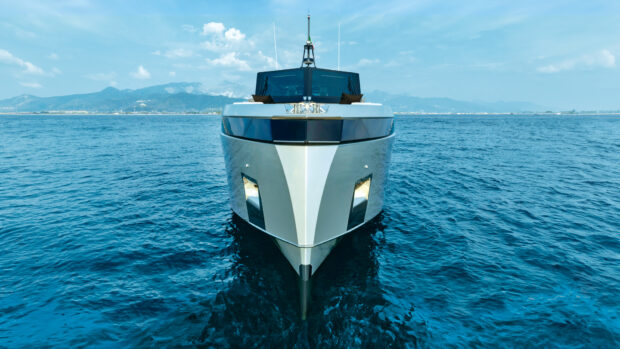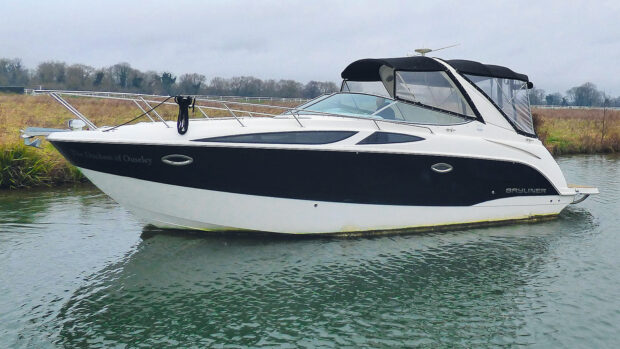With its rollcage and tenacious-looking matt-black shell, does the XO DFNDR live up to its road going counterpart?
There is a determined east wind barrelling across Poole bay and with the tide turning, it’s kicking up a shortly spaced, awkward chop ready to devour the 25ft hull of the XO DFNDR.
Ordinarily, if I were about to get behind the wheel of a boat of this size in these conditions, I would be making my excuses and rescheduling, but there’s no way the XO DFNDR is going to shirk a challenge.
How can it? With a black, spotlight-fringed cage protecting the four helm seats, a jerrycan lashed to the forward end, suspension seats for helmsman and navigator and a snorkel sprouting from the deck, if there was ever a boat to take on what’s waiting outside the shelter of the harbour, it’s this.
The looks aren’t a total gimmick, either. That cage can be enclosed by canopies and heated (hence the snorkel, which is actually the exhaust for the Webasto heating and not purely aesthetic) to keep you toasty on windy winter adventures.
The similarities to Land Rover’s iconic 4×4 (in looks and name) are hard to ignore and sitting at the chest-high wheel, it even feels like you’re driving a Defender. An upright, unfussy dash topped with a stubby windscreen and the throaty grumble of a pair of 4-cylinder Mercury 200hp outboards provide a suitably chattery backing track.

The upright helm position and suspension seats work brilliantly
There are plans to tweak some of the details here, like reducing the height of the lowest edge of the canopies so you don’t trip on them as you step into the helm seats, and covering the inside of the frame with some soft material in case the occupants accidently bang their heads.
The hull is the same as the regular XO 250, hewn from aluminium and topped with a GRP deck that feels a little more user friendly than the hard-edged all-aluminium interior of the likes of the Anytec 747. The difference between this and the 250 is that the motors are mounted further aft on a transom bracket and you can have twin engines.
It’s far from luxurious, though, the only creature comforts being some shock-absorbing seats for the lucky pair who are sitting at the helm and a very large dry storage area beneath the foredeck whose lid can be used as a sunpad.
Out in the rough stuff
Grizzly the 200hp Mercs may be, but they don’t half provide some shove to get the DFNDR out of the hole. Engage a small amount of the throttle and it’s up on its toes like a boxer waiting to throw the first punch. And the similarities don’t end there – the deep-vee hull is alert and agile, not to mention tough.
With such a messy, unpredictable sea, I misjudge the landing and we take a couple of whacks, but the DFNDR soaks it up, wipes its brow and prepares for the next one. We’re pushing 25 knots in speeds that would have your average 25-footer down to single figures; in calm seas, the DFNDR will top out well over 40 knots.

Storage beneath the bow and cushions can be installed to make a sunpad
The downside of having the twin motors is all that weight out back on a boat that tips the scales just shy of 1,500kg. It is very sensitive to trim and it takes some real attention on the tabs to get it to settle down.
On a day like this when the wave pattern is so unpredictable, this is hard work, and it’s made worse by the trim tab controls being located above the throttle so it’s almost impossible to use them without knocking the levers.
The single 300/350hp outboard option would likely improve the boat’s natural trim, be easier to handle and lose very little in terms of out-and-out speed.
There is a perfectly valid argument that XO’s own 240 Cabin and 250 are more useful boats than the DFNDR, but they don’t have the quirky charm or the sheer cool factor it possesses.
There are customers who are drawn to it simply because of the way it looks but there is at least some depth to the tough aesthetic. And, as a tool for watersports and adventure, it is brilliantly equipped. You can picture stand-up paddle boards lashed to the cage, some waterskis and a wakeboard and a day spent messing around with them.

The aluminium hull takes the chop with ease
When you’re finished, head over to the beach where the aluminium hull can be run straight up the sand without the need to anchor. Or, drop the hook and use it as a floating climbing frame.
The whole thing is built to last and to be hosed down at the end of the day without worrying about ruining precious fabrics or scratching GRP. It’s utilitarian and fit for purpose – sound familiar? The Land Rover Defender may have gone, but in the DFNDR, it has a rather special waterborne homage.
Contact Wessex Marine. Tel: +44 (0)1202 700702. Web: www.xoboats.com
Pros
- The way it looks
- Functionality
- Seakeeping
- Performance
- Well protected driving position
Cons
- Sensitivity to trim
- Position of the trim tab controls
- Not as practical as the normal 250
Price as reviewed:
£102,540.00 as reviewed
Verdict
Many will simply fall for the looks and others will see how pracitcal, useable and cool it is. A great perfomer but likely better suited to a single engine
Details
Length: 25ft 5in (7.76m)
Beam: 7ft 5in (2.28m)
Fuel capacity: 78 imp gal (355 litres)
Draught: 3ft (0.9m)
RCD Category: C for 5 people
Displacement: 1.48 tonnes (boat only)
Test engines: Twin Mercury 200hp
Top speed on test: 43 knots
Price from: £87,756 inc VAT











